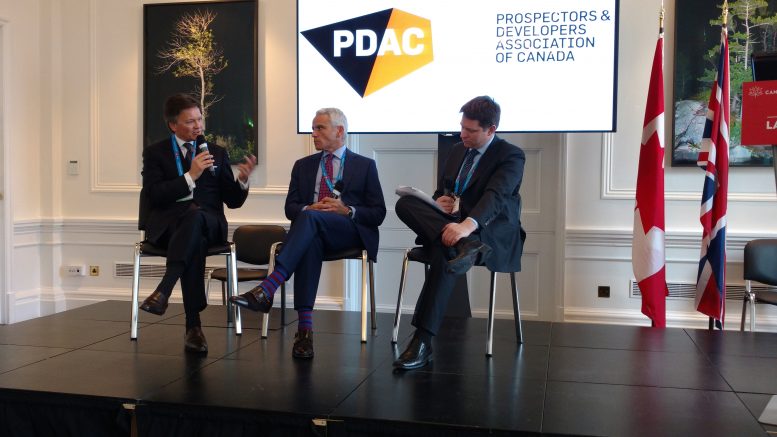At the Canadian Mining Symposium hosted by The Northern Miner at Canada House in London in May, session moderator Greg Huffman, managing director and global head of mining sales at Canaccord Genuity, sat down with Barrick Gold (TSX: ABX; NYSE: ABX) president Kelvin Dushnisky and Goldcorp (TSX: G; NYSE: GG) president and CEO David Garofalo for an in-depth conversation on the strategies they use to guide both companies, plus a look at what the future holds for gold mining globally. The following is an edited transcript of the exchange.
Greg Huffman for The Northern Miner: Looking at some of Goldcorp’s latest acquisitions — such as Gold Eagle, Virginia, Probe and Kaminak — is there now a premium on assets in safer jurisdictions, given the current political turmoil worldwide?
David Garofalo: It’s always been fundamental to Goldcorp’s strategy to stay in low political-risk jurisdictions, generally investment-grade countries, with the exception of taking a bit more risk in investing in Argentina before the Macri regime. But that was a generational asset in Cerro Negro, and it’s been born out in the changing regime there and the Macri economic model.
Fundamental to our story is that we’re focused on the Americas and our own time zones. It makes it an eminently more manageable company.
In my 27-year career I’ve worked with mining companies that are spread out across multiple jurisdictions on multiple continents, and this introduces an element of risk and complexity to managing assets that makes it hard to run the company, and requires a risk premium associated with operating across too many jurisdictions.
One of the reasons Goldcorp historically has gotten a good multiple is because of its stringent geographical and geological focus.
TNM: Barrick has operations in many countries. How have you decentralized the company to deal with the increased jurisdictions and associated risks?
Kelvin Dushnisky: In 2016, 70% of our production was from our five core mines in the Americas: Goldstrike, Cortez, Pueblo Viejo — where we’re partnered with Goldcorp — Lagunas Norte and Veladero. That represents 50% of our reserves.
Outside of this, in some of the other jurisdictions we’re operating, we factor in political, technical and financial risk. Part of what we try to do in terms of managing risk is develop various layers, starting with local procurement and hiring practices, understanding local politics and influences on policy — be it local, provincial or state, or federal — and ensuring that we have strong relationships in that respect.
We also look to jurisdictions where investment treaties could exist, ranging from Canada, which uses foreign investor protection agreements or even better, where we have free trade agreements with strong investor protection chapters. Those help us.
We layer in various strategies to manage risk, and it has worked out well.
TNM: What do Canadians bring to the table that may separate us a little from some of the other mining nations?
DG: We have a long mining history, and more importantly we have the mining infrastructure that comes with that. And I mean “people infrastructure” — not just physical infrastructure — that we’re able to export, whether it’s banking, legal or financial expertise that we’ve developed over more than a century of mining in Canada.
Accessing risk capital to work in the sector, predominantly within our own country, but also we’ve been exporting this over the last 30 years or so. When Latin America opened up as an investment, we were one of the first countries to rush in and develop, for example, the Chilean copper sector.
This brought a whole new level of expertise to Canada that is the envy of the industry.
KD: I’d agree. The infrastructure exists and the services exist. There is also the stock exchange and the predominance of publicly listed companies that trade on the Toronto Stock Exchange. And it’s more than that. It’s cultural — the familiarity with the space. Canada was mining before Canada was a country. Canada and mining, it’s a little bit like Italy and sports cars and the fashion industry. You don’t get that overnight.
It’s important that we protect it. Maintaining the brand is important. There’s a strong element of support from the Canadian government, and in our ability to wrap ourselves in the Canadian flag. We found that to be extremely effective as we operate abroad, in particular. It’s all part of the mix.
Generally speaking, the country is perceived well. A recent example is other countries and jurisdictions adopting the Mining Association of Canada’s Towards Sustainable Mining framework for their own use. That reflects well on Canadian companies.
TNM: Goldcorp and Barrick have strong records of community engagement across your operations. Are Canadians doing enough on Corporate Social Responsibility (CSR) to keep our social licence as well as good reputation as responsible miners?
DG: When it comes to CSR, it’s all about water. And as an industry, we could be a lot less water-intensive than we are. That’s a source of significant social conflict. It’s an impediment to getting both a social licence to operate and getting projects permitted.
It’s the biggest factor in the space. As an industry, we need to make technological advancements that lower our water consumption and enhance our ability to develop projects.
That, by far, is the biggest impediment to developing projects. It causes untold conflict with surrounding communities. Even if you have the perception of using scarce resources, even if it’s not true, against agricultural activity, you are not going to get the social licence to operate.
We’ve seen example of that time and again in our space. And given how difficult it is for us to replace reserves, if we don’t attack that issue of water use in our industry, it’s going to be hard to perpetuate our businesses in the long run.

“We’re trying to de-risk projects to the extent we can, and build in stages whenever we can, instead of the ‘swing for the fences’ model.”
Kelvin Dushnisky
President
Barrick Gold
TNM: Recently Barrick and Goldcorp partnered on the Cerro Casale-Caspiche assets, which are in a water-sensitive area. Do you see synergies by putting these projects together, from a permitting, water-use and cost perspective?
KD: That was the purpose of us coming together. We’re enthusiastic about the new partnership and think Goldcorp will bring fresh perspective, thinking and energy to that situation.
Cerro Casale is interesting in that we have water rights … that relate to a particular aquifer — without getting into the technical details — and that’s something that is relatively rare.
I agree with David that water could be the industry’s Achilles’ heel if we don’t manage it carefully. Over the last year we have hired and put in place a vice-president for water, dealing with both near-term environmental issues and looking out over the longer term at policy and other issues that could affect us, both as a company and as an industry.
TNM: What about on the government-relations standpoint? Permitting is a big aspect of that, but with the rebound in commodity prices are you starting to see indications that governments may seek a bigger slice of the pie? And are there ways for industry to better insulate investors from this risk?
KD: We as a company and industry can better communicate to host governments and locally the benefits that come from mining. For example, in 2016 alone, we spent US$5.3 billion in various jurisdictions where we’re operating as taxes, royalties, wages, local procurement, etc.
I don’t think we’ve communicated well enough to governments the timelines associated with our investment. There’s a sense that as soon as you make the investment, you’re generating big returns, when the reality is that it takes a long time to pay back all our capital in this business.
TNM: What about personnel risk? Where do you see the greatest skill shortages in the industry right now?
DG: It’s trades. A lot of trades have skills that are transferable to an urban environment. If you’re trying to raise a family or, for that matter, start a family or a relationship, it’s much easier to do in an urban environment than it is if you’re a young person in a mining camp or an isolated part of the world where you might be mining. That’s a significant challenge.
I don’t think we’ve done a good job — at least in Canada — of importing those skills that we require, because trade schools are not turning out enough people to meet our shortages, whether it’s mechanics or electricians and the like. These are skills that are easily transported into urban environments, so we have to pay a premium to get them, but there’s just not enough of them even if we’re paying the premium.
KD: I agree with David, plus the traditional careers: engineers and geologists. We went through that period a decade or so ago when mining wasn’t the most attractive place, and kids weren’t going into the engineering and geology programs.
The other challenge is attracting younger people into our space. We need people who can write code and have other skills beyond the classical trades.
We’ve done survey work and if you ask kids who have recently graduated, would you rather go to Google or Facebook or Apple or Barrick, we’ve got a pretty high bar to get kids to come to a mining company.
We held recently — and I didn’t even know what this thing was until I was told — a “hackathon,” where younger people assembled in a room and brainstormed a maintenance problem and a geological issue. We had kids from all over the place with different backgrounds coming at these various problems.
One of them interviewed at the very start and we asked him, “What do you think of the mining business?” And he said, “Who would go into it? It’s a dinosaur industry.”
At the end of the weekend, the response was actually very cool. They said there were a lot of areas where they could apply their talents and be innovative and creative.
As an industry we have to be more attractive to young people and send that message.
I can’t think of another business that touches on every single aspect of commerce, from financing, marketing, engineering to communication. Pick a topic area, and we touch on it one way or another, but that’s not well understood.
TNM: Are schools doing enough to groom the next generation of mining leaders?
KD: The Canadian schools are doing their part. They’re responding to demand, so part of what we need to do as an industry is support the Canadian schools. We’re doing our part, but probably not as systematic as we should and could, and that’s something we’ll focus on.
In terms of succession, we have what we call “Barrick Academy,” where we do more internally to groom the next generation of mining leaders, and that resonates well in the company.
We’re seeing an attraction of people to Barrick now. I’ll be honest, you go back three or four years and there was an outflow of talent from Barrick to our friends [grabs and shakes Garofalo jokingly]. We’re happy to see an inflow back, but we can’t get complacent — that’s the risk. We have to be vigilant and keep the space attractive.
TNM: The market over the past year has started to look at production-growth profiles again, compared to 12 months ago when they mostly looked at free cash flow. For companies of your size it becomes hard to fill that production pipeline because you need big, meaningful assets. What’s the next step in de-risking those large assets from a financial aspect? For instance, raising the capital to buy and build these mega-projects.
DG: First you have to make an investment case, and that’s probably the biggest impediment to raising capital — finding the investment opportunities that generate an adequate rate of return to attract the capital.
As an industry we are facing a reserve cliff. Over the last five years in the gold sector we’ve seen a one-third decline in our reserves. In case you think that’s because we’re using lower gold-price assumptions, that’s actually not true — it probably accounts for 30% of that decline. Seventy percent is actually depletion.
We haven’t been investing back in the ground, not only in terms of exploration, but also in terms of de-risking projects, bringing them though the pipeline and making that investment case to try to attract financing.
The capital is out there if you can show an adequate rate of return, but we haven’t de-risked large-scale projects sufficiently to replace what we’re depleting.
If you look at the production perspective, by our own admission, the industry will shrink production by 15% to 20% in the ensuing five years.
And that’s because declining reserves are the leading edge of that. Obviously production will decline as reserves decline.
As an industry, we have to collaborate more. None of us should take on our shoulders individually the response of reversing that downward trajectory of reserves. We have to collaborate to bring meaningful projects forward.
And those projects are declining in grade. The average mining grade today of a gram a tonne is half of what it was 15 years ago. We have to do bulk tonnage, with bigger equipment, to deliver those economies of scale and make those lower-grade deposits economic.
But none of us need to take on capital risk ourselves, nor the project risk and technical risk.
The model we’re pursuing with Teck at NuevaUnion and with Barrick at Maricunga is one we have to pursue going forward, to share the financial and technical risk with well-capitalized partners.
So we avoid the Sudburys, the Nevadas, and for that matter, the Red Lakes of the world, where we built duplicative infrastructure on the same deposits and massively destroyed capital. That drove away investors from the industry.
I’m encouraged that we have a new generation of CEOs in this space over the last four or five years that have a different mindset. They are taking that capital discipline and bringing it to bear within the sector, where traditionally that hasn’t been the case.
TNM: Barrick has partnered on a number of assets over the last 18 months. Could you go through your evaluative process for finding partners for various assets?
KD: The reality is that we haven’t entered into a partnership yet where we don’t see a longer-term strategic fit. So it’s partly about capital, but not only about capital.
From our perspective — and I agree with everything David just said — we’re trying to de-risk projects to the extent we can, and build in stages whenever we can, instead of the “swing for the fences” model.
A real-life example is that we’re dealing with our Goldrush project in Nevada. Goldrush has 11 million oz. and growing, and when we first looked at the deposit, we did the classic “this is Nevada” approach and drew a 1- by 2-mile circle around it as a potential open pit, and started thinking about how we could develop it.
We realized this could be interesting, but we’d prefer to develop Goldrush as a smaller, lower-capital underground mine. It’s quicker to bring it into production, and requires much less capital. In this case, there’s very little capital risk, as we’ll take advantage of the Cortez and Goldstrike facilities nearby. So it’s unique in that regard.
But to the extent that we can build in stages, and use cash flow to pay for subsequent stages, that’s how Goldstrike was built. It wouldn’t be a mine today if we had tried to build it all at once in the 1980s.
In terms of partners, one example is that we sold half of our Zaldivar copper mine to Antofagasta because we had a view that, even though we thought we were running it well, they could probably run it better, given their synergies and long history and understanding of operating in Chile.
And that turned out to be the case. Just like if they had a single asset in Nevada, we should probably be able to run that mine better than they could.
Goldcorp is going to bring a lot to the equation at Cerro Casale, and there are synergies with their other activities in Chile.
In every instance, we’re looking for something strategic in the fit. And if we find that, it makes sense for us to partner. And if not, we’re happy to run the asset on our own.
TNM: David, you talked about the decline in reserve grades globally. With a lot of the low-hanging fruit gone, will the new generation of mines come from discoveries, or is it going to be a new look at old deposits?
DG: Probably a combination thereof, and I know that’s a bit of a cop out.
But as we see technological advancement, the next frontier for us is artificial intelligence and driverless vehicles within our mines that will drive down labour costs, which is a big component.
That will allow us to look back at lower-grade deposits that may not make the cut right now, to replace what we’re depleting.
TNM: Barrick is making a big investment in new technology. What could be the most game-changing or disruptive technology that will change our business?
KD: When we decentralized our business in recent years, what we found as we cleared away the middle layer between head office and the mines was an increased flow of information between the two. We unclogged the artery.
But while we were in a position to make better decisions, what we were lacking was real-time data to make those decisions with. So part of our effort intensively over the last year has been digitization from the mines all the way to head office.
It’s a process, and it’s going to take us a while to get there. But already we’re finding the ability to make decisions more quickly.
They’re simple things like short-interval controls — how we move people around, both in the open pit and underground in a more efficient way than we ever did in the past.
These are small things that really add up, shift after shift, week after week, month after month. We’re seeing gains that way.
Beyond that, the use of autonomous vehicles, especially underground, is something that will be very important to us. More of our mines are likely to be underground as we move to the next generation, so it’s going to be even more compelling.
We’re trying to apply innovation throughout our business, from processing to better maintenance. We have a “code mine,” which is kind of a mini-Google campus where we have code writers working with our mine operators to develop apps that make their day more efficient and easier, and we’re already seeing results from that.
So it’s a combination of things, rather than one “eureka!” breakthrough.
TNM: David, while at Agnico and Hudbay, you had an effective strategy of investing in juniors with prospective discoveries and projects. Is grassroots exploration best left to the juniors, with seniors focusing on brownfields exploration near mines? Or is there a balance?
DG: It requires a different mindset to do grassroots exploration, and it has a completely different risk profile and skill set. It is best left to the juniors.
Grassroots exploration is the highest-risk component of value creation within our industry.
Portfolio theory tells you that when you have risk, diversify it. Our strategy at Agnico, Hudbay and now Goldcorp was really to diversify that exploration risk through the juniors.
That also provides you the opportunity to leverage management in jurisdictions and districts that maybe you don’t have an expertise in.
Give them the capital, and if they’re successful, re-up. And if they’re not, cycle the capital to other another opportunity.
That gives you some steady optionality in your pipeline, and you can populate your pipeline over time.

“As an industry, we could be a lot less water-intensive than we are. That’s a source of significant social conflict.”
David Garofalo
President and CEO Goldcorp
TNM: Could you comment on using that approach during extended market downturns like the one we just came out of? Is there a better way to support exploration, or do we operate at the whim of the market?
DG: We can complement the market. When the juniors have access to capital markets, we tend to have less engagement with them, which is fine, and we can watch them from afar.
But it’s good to act as a bit of a merchant bank when the capital markets aren’t there.
Recently that hasn’t been the case, though not for all juniors. The market has been a bit surgical in terms of allocating capital to the junior space.
We’ve been able enter the breach, and that has given us exposure to very good management teams and prospective ground.
TNM: What is Barrick’s strategy when it comes to investing in juniors?
KD: We’ve announced in the last 18 months three particular investments: most recently with Atac Resources in the Yukon, before that with Osisko in northern Quebec and before that Alicanto in Guyana. We like all three of these opportunities.
The approach we’re taking is not a shotgun approach. We spent a lot of time evaluating the management teams, and we’re pleased with the exploration groups that are on the ground. Our ability to participate in the program is supposed to be passive, in that respect.
You should expect to see more of that from us.
But at the same time, we’ve increased our budget both for brownfield and greenfield exploration. Part of that is because of the results we received at Goldrush in Nevada and Alturas in Chile and potentially extending into Argentina. Our finding cost is about US$25 an ounce, so we’re going to push ahead on both fronts.
TNM: Going back to the Caspiche-Cerro Casale transaction, David you were quoted as saying this was done at US$15 an ounce. So is it cheaper to find or buy ounces, and are you going to look for more at the US$10 to US$15 per ounce level?
DG: We’re always going to look for opportunities that can deliver 5 to 10 million oz. reserves, and upwards of 500,000 oz. annual production.
We do believe that the equilibrium level of production for a senior gold company is somewhere in the 3 to 4 million oz. a year range. And you want to do that with as few assets as possible so that you have economies of scale inherent in the districts you operate in.
As a result, we’re always looking to increase value, not increase volume.
That means driving down cost structures, but it also means, when you have the opportunity to upgrade your portfolio, do so.
And be quite ruthless about rotating capital from something at the bottom of your portfolio to something that can move the needle, both in terms of production volume over time and net asset value.
TNM: Both companies have strong balance sheets. What are your thoughts on your abilities to pay out dividends to your shareholders?
DG: In a cyclical business it’s very, very difficult to have an increasing dividend rate. Inevitably that creates an overhang in the stock. I’d sooner return capital in other forms if our balance sheet got a little sloppy.
If gold ran up to US$2,000 per oz. for a period of time and we had all sorts of excess cash flow and we didn’t have investment opportunities that met our hurdle rate, you could do a special dividend or a share buyback.
But we have a collection of finite-life assets, and shareholders want us to compound our returns so that we can generate opportunities that meet our hurdle rates. So our priority is regenerating our business, given its finite nature.
KD: Paying a consistent dividend as part of total returns is important to us, and we like the discipline. But David is right, we’re at a point where the key over the last two years was bringing down our debt and strengthening our balance sheet. We’ve reduced our debt by 40% in the last two years, and liquidity is strong.
Depending on what happens you should expect us to increase the dividend, but we’ll be prudent. We’re not going to get ahead of ourselves.
TNM: Royalty and streaming companies compete for the same investor capital that miners do. What are the biggest advantages for investors to put money into mining companies?
KD: There’s space for streamers, royalty companies and exchange-traded funds (ETFs). The advantages in investing in solid, operating companies is our ability to take advantage of our respective pipelines and add value, for instance with exploration, and the ability to manage our costs well.
That’s going to be key: keeping that level of discipline, including in a rising gold-price environment. Because that’s not what we did during the last cycle when prices went up and we became a little undisciplined. We didn’t take advantage of margin expansion, and in that context you shouldn’t have been buying a gold company. That’s just a reality.
TNM: If we look at gold ETFs, they’ve become challenging for investors because they’ve somewhat outgrown the investable universe. We’re seeing ETF changes impact gold company valuations, more in the mid-tier and small-cap space. What is your take on the affinity investors have for ETFs over individual mining companies?

Goldcorp president and CEO David Garofalo (left) and Northern Miner publisher Anthony Vaccaro at the Canadian Mining Symposium in London, United Kingdom. Photo by Martina Lang.
DG: It has created a bit of a disconnect. And I’m not saying this to whine, it’s just a reality that an increasing amount of capital in equity markets is being managed by machines. And the machines are focused on the multiples and the valuation metrics that are prevalent across other industries, which are short-term price to earnings, short-term price to cashflow, etc.
What we’ve seen is a lot more volatility around quarterly earnings releases.
Of course, our investment horizon’s quite a bit longer in the mining space. It’s a minimum of a decade from discovery to first gold pour.
Sometimes we have to make investment decisions for the long term that might not get traction in the marketplace in the short term.
That presents a challenge, and I don’t know what the answer is. Perhaps a much stronger metal price will resolve that in the short term.
TNM: Do you see a wave of consolidation coming in the gold space, particularly in the mid-tier?
DG: It’s challenging to do that, because there aren’t too many players of significance left in the gold sector.
Quite often the companies that might be obvious targets for sector consolidation generally have a disparate collection of assets geographically and geologically that might not fit the portfolios of established producers.
So you’re ending up having to buy five or six assets in a portfolio to get the one that you like. This erodes the value proposition, because you have to go into the divestiture phase for the assets that are non-core. I can guarantee you are unlikely to realize the value if the bankers are pitching you going into that kind of transaction.
The model for replacing reserves is to collaborate on large-scale opportunities and lower the capital burden. This means consolidating districts and sharing the financial and technical risk to bring large-scale geological opportunities to mine production.
TNM: How do we ensure Canada remains a sector leader globally in gold mining?
DG: It’s hard to kill. There was a lot of consternation that the base metals sector consolidated quite dramatically a decade ago, but it’s like chopping off the top of a hedge — it grows back.
There’s that entrepreneurial class within the mining space in Canada that’s second to none. I don’t know as robust a junior sector that there is in Canada, and that’s helped regenerate the industry in a significant way, even after massive consolidation. And that’s true in the gold space as well.
KD: It’s in our DNA, and it’s up to us to protect it and promote it. We have the pole position, and we’ll continue to keep it.






Be the first to comment on "In-depth interview: Barrick’s Dushnisky and Goldcorp’s Garofalo on gold mining’s future"